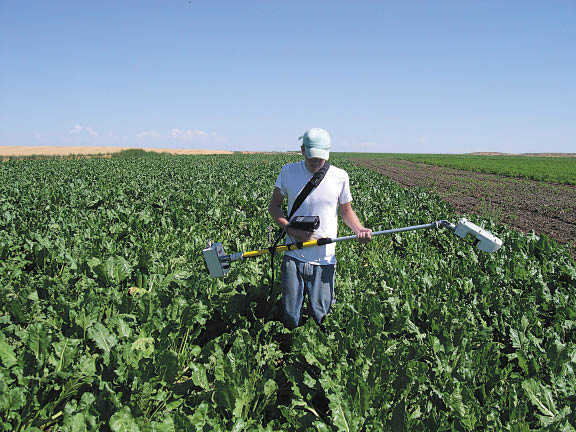 The Problem
The Problem
Phosphorus nutrition is vital for maximizing crop production.
Unfortunately only a small percentage of the fertilizer applied as phosphorus actually enters the plant in the first year after application.
Studies show that uptake of phosphorus, in a worst-case scenario, is near 0 and up to about 30 percent with optimum rate, placement and timing. In calcareous soils common to many sugar producing areas in the Western U.S., broadcast and incorporation of phosphorus results in about a 5 percent recovery. Applying the phosphorus in a band increases the efficiency to about 25-30 percent. Similar recoveries occur in very acid soils. Uptake of phosphorus by plants grown in soil with near neutral pH results in better recovery, but it's still less than 35 percent.
Increasing the amount of phosphorus entering a sugarbeet plant is especially challenging in the high pH and high lime containing soils. The reason for this is due to the dramatically decreased solubility of phosphorus when soil pH is high (alkaline) and further reduction in solubility in the presence of free excess limestone or "white soils."
A similar phenomenon occurs in acid soils-with phosphorus forming poorly soluble combinations with iron and aluminum.
The phosphorus must be in liquid form in order for plants to utilize it. One can think of it as plants having to drink their nutrients from soil, which can't happen if the nutrient is in solid form. Although some of the precipitated mineral phosphorus can re-dissolve and be taken up by plants, this process is generally inefficient and is the reason for poor fertilizer uptake percentages.
Don't be tricked to think that this means we should only apply liquid fertilizers-the reality is that most good dry fertilizers dissolve to liquid quickly in soil, but both end up "precipitating" or "salting out" in a short time, especially for phosphorus fertilizers.
One solution to the phosphorus availability problem would be to combine it with another chemical that maximizes the amount dissolved in soil solution.
We have experimented for many years with these possible products with varying successes. Most notably, Land View Fertilizer (Rupert, Idaho) has recently developed a product (Carbond P) that blends phosphorus with various organic acids and suite of other constituents. We have identified the molecule formed in this product and found it to be consistent from batch to batch, as well as discovering that it lasts mostly through a growing season.
Several laboratory, greenhouse and field trials have been conducted over the last five years showing Carbond P does enhance phosphorus solubility and uptake into a variety of crops. We see increased phosphorus uptake in more than 90 percent of the dozens of trials we have conducted. Utilizing this technology allows for reduced application rates due to increased efficiency (higher percentage of the phosphorus is taken up by plants) without reducing yields. In fact, in many cases yields have been higher with Carbond P.
Trial results
Yield and/or crop quality increases have been shown in a variety of crops, especially when soil test phosphorus concentrations are relatively low. A trial performed on sugarbeet with a soil-test concentration of 13 ppm bicarbonate extractable phosphorus on a pH 8.0 soil with 5.2 percent lime resulted in a somewhat typical response of what we have observed with Carbond P in various crops.
The ammonium polyphosphate (10-34-0) resulted in an expected increase in yield over the control with a somewhat linear response as the rate increased from 50 to 100 pounds P2O5 per acre (see Figure 1).
However, the Carbond P (7-24-0) achieved maximum yield at a much lower rate. Tests with a wide variety of crops have shown that Carbond P works best at lower rates. We comfortably recommend a reduction of 30 percent and suspect that the efficiency may be as high as 50 percent, although further work is needed to confirm this hypothesis.
Recommendations
I recommend determination of the normal rate of phosphorus that should be applied based on research-based fertilizer trials and then a reduction of 30 percent (up to 50 percent) of phosphorus applied when using Carbond P.
We have also performed several trials using Carbond P as a foliar application, which is also effective. However, foliar application should not take the place of soil applied phosphorus, but should be viewed as supplement when needed. Uptake efficiency and yield response have been greater when the phosphorus is soil-applied.
In addition, our trials show that the phosphorus needs of sugarbeet plants are most important early in the season when the taproot has strong downward growth and little lateral growth-thus it is not exploring the phosphorus rich topsoil and, instead, is exploring the phosphorus depleted subsoil.
Phosphorus deficiency at this time of year results fewer and less thick cambial rings. Yield potential is reparably lost when this happens and can even occur on soils with high residual phosphorus levels.
Study results shown here were applied in a wide band over the seed row, which is effective when soil test phosphorus is low. In soils with higher soil test phosphorus (common following potato crops), I normally recommend an application of a low rate (3-5 gallons per acre) of banded phosphorus directly below (3-6 inches) or on the seed (with caution to avoid salt damage).
Alternatively, a low rate foliar application directed over the top of the plants at early stage (4-6 leaf) can be equally effective. I do not recommend applying late-season applications of phosphorus as they often cause reductions in sugar percentages. Once the plant begins exploring the top soil extensively (after 8-12 weeks), it is very efficient at scavenging for nutrients and excesses can be detrimental.